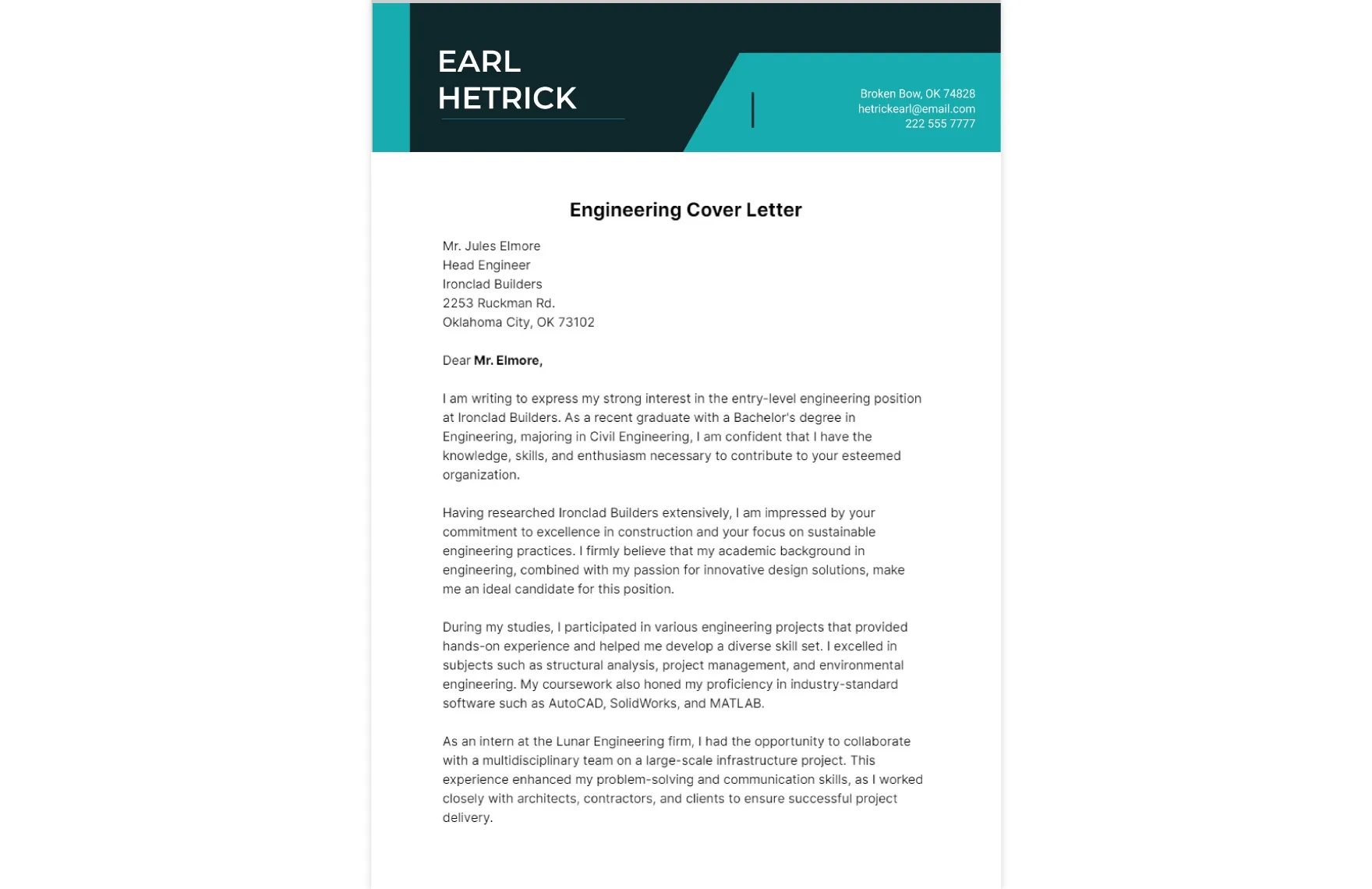What is an Engineer Cover Letter?
An engineer cover letter is a crucial document that accompanies your resume when applying for engineering positions. It serves as your introduction to a potential employer and provides an opportunity to showcase your skills, experience, and enthusiasm in a personalized way. Unlike a resume, which provides a concise overview of your qualifications, a cover letter allows you to elaborate on specific achievements, explain your career goals, and demonstrate your understanding of the company and the role you’re applying for. It is your chance to make a strong first impression and convince the hiring manager why you are the ideal candidate for the job. Crafting a well-written cover letter is essential for any engineer seeking to advance their career.
Why is an Engineer Cover Letter Important?
The importance of an engineer cover letter cannot be overstated. Firstly, it demonstrates your genuine interest in the specific position and the company. A generic resume sent without a cover letter may suggest a lack of effort or interest. Secondly, it allows you to provide context to your resume. You can explain how your skills and experiences align with the specific requirements of the job, highlighting relevant projects and achievements that might not be immediately apparent from your resume. Thirdly, a well-written cover letter gives you the chance to showcase your communication skills, which are vital in any engineering role. It allows you to express your personality, enthusiasm, and commitment to the field, helping you stand out from other applicants. In today’s competitive job market, a strong cover letter is often the deciding factor in whether you get an interview or not.
Essential Components of an Engineer Cover Letter
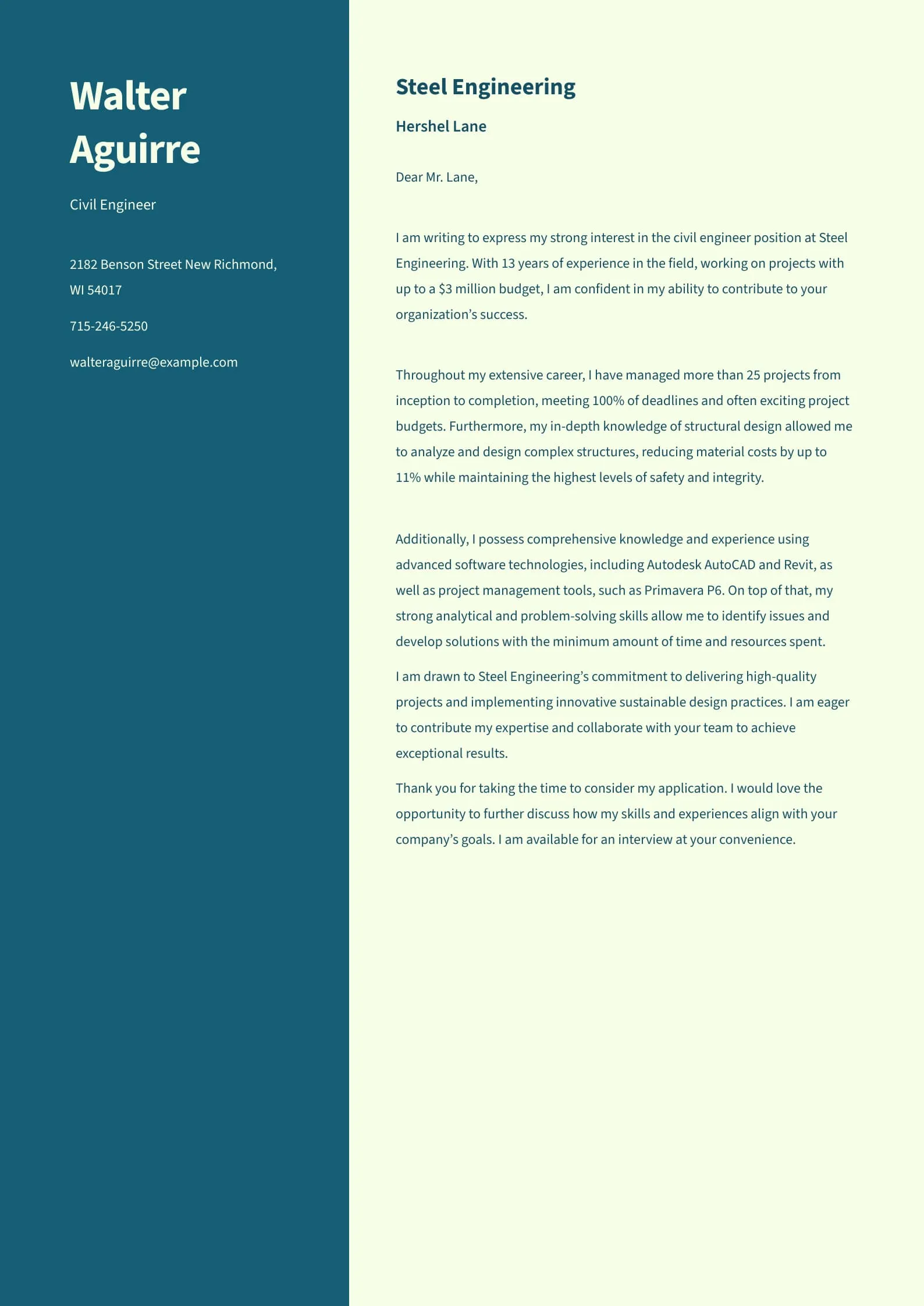
A compelling engineer cover letter should include several key components to effectively convey your qualifications and enthusiasm. Begin with your contact information and the date, followed by the hiring manager’s name and the company’s address, if possible. The salutation should be addressed to a specific person whenever possible, using ‘Dear Mr./Ms./Mx. Last Name.’ The opening paragraph should immediately grab the reader’s attention, expressing your interest in the position and mentioning how you learned about the opportunity. The body of the letter should highlight your relevant skills, experience, and achievements, providing specific examples to support your claims. Quantify your accomplishments whenever possible, using numbers and data to demonstrate your impact. Conclude with a strong closing paragraph, reiterating your interest, expressing your enthusiasm, and including a call to action, such as requesting an interview. Finally, always proofread and format your cover letter carefully before submitting it.
Contact Information and Salutation
The header of your engineer cover letter should include your contact information, such as your name, phone number, email address, and LinkedIn profile URL (if you have one). This information ensures that the hiring manager can easily reach you. Following your contact information, include the date. Then, address the letter to the hiring manager. Research their name and title if possible, and use a formal salutation like “Dear Mr./Ms./Mx. Last Name.” If you cannot find the hiring manager’s name, use a general greeting like “Dear Hiring Manager.” Addressing the letter to a specific person shows that you have taken the time to research the company and the role, making a positive first impression.
Opening Paragraph How to Hook the Reader
The opening paragraph is your chance to hook the reader and capture their attention. Start by clearly stating the position you are applying for and where you saw the job posting. Then, immediately express your enthusiasm for the opportunity and the company. Briefly mention something specific that attracted you to the role or the organization, demonstrating that you have done your research. Avoid generic opening sentences; instead, tailor your introduction to the specific job and company. The goal is to make the hiring manager want to read further and learn more about your qualifications. A strong opening sets the tone for the entire cover letter and significantly increases your chances of getting noticed.
Highlighting Your Skills and Experience
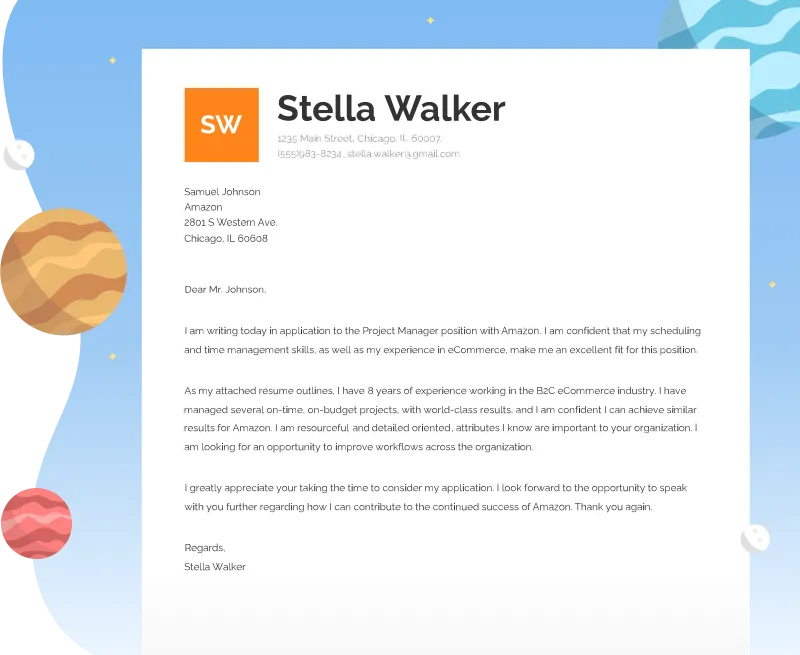
In the body of your cover letter, you should highlight your relevant skills and experience, focusing on how they align with the job requirements. Refer to the job description and identify the key skills and qualifications the employer is seeking. Provide specific examples from your previous experiences that demonstrate your proficiency in these areas. Use action verbs to describe your accomplishments and responsibilities. For instance, instead of saying “Responsible for project management,” say “Managed cross-functional engineering projects, delivering on time and within budget.” Show, don’t just tell, the hiring manager what you can do. Tailor each cover letter to the specific job, emphasizing the skills and experiences that are most relevant to the role.
Showcasing Relevant Projects and Achievements
To truly impress a potential employer, showcase your relevant projects and achievements. Don’t just list your responsibilities; explain the impact of your work. Describe specific projects you have worked on and your role in each, highlighting your contributions and the outcomes achieved. For example, if you were involved in a design project, explain the challenges you faced, the solutions you implemented, and the results achieved, such as improved efficiency, cost savings, or product performance. Use the STAR method (Situation, Task, Action, Result) to structure your descriptions, providing a clear and concise overview of your accomplishments. This approach helps the hiring manager understand the value you can bring to their organization and how you have successfully applied your engineering skills in real-world scenarios.
Quantifying Your Accomplishments
Quantifying your accomplishments is a powerful way to demonstrate your impact and value. Instead of making vague statements about your achievements, use numbers, data, and metrics to showcase your success. For example, if you improved a process, state the percentage by which you reduced errors or increased efficiency. If you saved the company money, specify the amount of the cost savings. If you led a team, mention the size of the team and the results achieved. Quantifiable data adds credibility to your claims and provides concrete evidence of your abilities. This approach helps the hiring manager understand the tangible benefits you can bring to the role. Whenever possible, back up your statements with numbers to make your cover letter more compelling and persuasive.
Expressing Your Enthusiasm and Fit
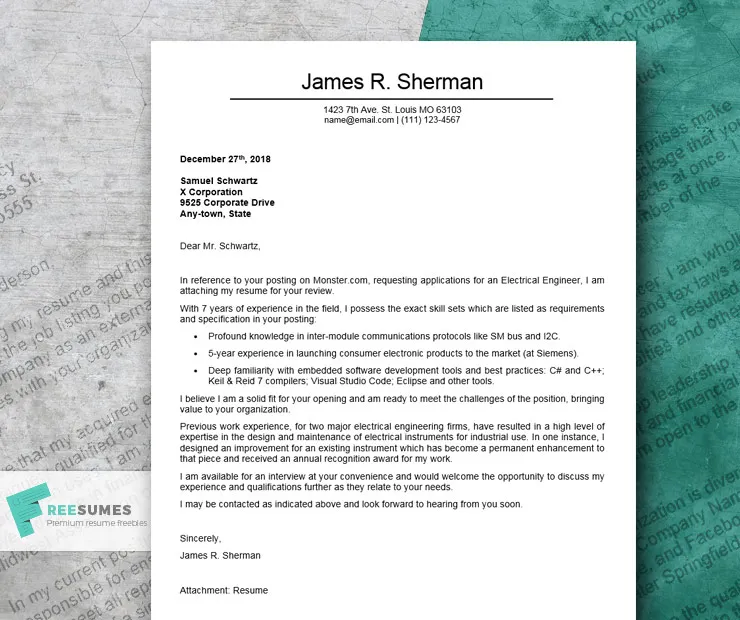
Expressing your enthusiasm for the role and demonstrating that you are a good fit for the company is crucial. Show that you have researched the company and understand its mission, values, and products or services. Explain why you are excited about the opportunity and how your skills and experience align with the company’s goals. Mention specific aspects of the job or the company that appeal to you, showing that you are genuinely interested in the position and not just applying for any job. This demonstrates your commitment and increases the likelihood of the hiring manager seeing you as a good match. Your enthusiasm can be the deciding factor when the hiring manager is choosing between several qualified candidates.
Closing the Cover Letter
The closing paragraph of your engineer cover letter should reiterate your interest in the position and express your enthusiasm for the opportunity. Thank the hiring manager for their time and consideration. Include a call to action, such as requesting an interview or expressing your eagerness to discuss your qualifications further. Reiterate your contact information and provide a professional closing, such as “Sincerely” or “Best regards,” followed by your name. Proofread the entire letter one last time to ensure there are no errors before submitting it. A well-crafted closing leaves a lasting positive impression and encourages the hiring manager to take the next step in the hiring process.
Proofreading and Formatting Your Cover Letter
Proofreading and formatting are essential aspects of creating a professional engineer cover letter. Carefully proofread your letter for any grammatical errors, spelling mistakes, and typos. Ensure that your writing is clear, concise, and easy to understand. Pay attention to the formatting and layout of your cover letter. Use a professional font, such as Times New Roman, Arial, or Calibri, with a font size between 10 and 12 points. Use consistent spacing and margins to create a clean and organized appearance. Break up large blocks of text into smaller paragraphs to improve readability. A well-formatted and error-free cover letter demonstrates your attention to detail and professionalism, both of which are highly valued in engineering roles.
Formatting and Layout Best Practices

Adhering to formatting and layout best practices ensures that your engineer cover letter is professional and easy to read. Use a standard business letter format, including your contact information, the date, and the hiring manager’s information. Left-align the text and use single-spacing within paragraphs and double-spacing between paragraphs. Use clear and concise language, and avoid jargon or overly technical terms that the hiring manager might not understand. Keep the letter to one page in length, focusing on the most relevant skills and experiences. A well-formatted cover letter demonstrates your ability to communicate effectively and presents you as a polished and professional candidate, enhancing your chances of securing an interview.
Common Mistakes to Avoid in Engineer Cover Letters
Avoid making common mistakes that can negatively impact your engineer cover letter. Do not use generic or boilerplate language; tailor each letter to the specific job and company. Avoid simply restating your resume; instead, elaborate on your accomplishments and provide context. Do not include irrelevant information or personal details. Avoid grammatical errors and typos. Do not exceed one page in length. Do not send the wrong cover letter or the incorrect version of the letter. Always proofread your cover letter carefully before submitting it. Avoiding these common mistakes will significantly increase your chances of making a positive impression on the hiring manager.
Tailoring Your Cover Letter to Specific Jobs
Tailoring your cover letter to specific jobs is critical for demonstrating your interest and qualifications. Each job requires different skills and experiences, so customizing your letter shows that you understand the requirements of the role. Start by carefully reviewing the job description and identifying the key skills and qualifications the employer is seeking. Then, highlight the relevant skills and experiences from your background, providing specific examples that demonstrate your proficiency. Explain how your skills and experiences align with the needs of the role and how you can contribute to the company’s success. Tailoring your cover letter demonstrates that you are a serious candidate who has taken the time to understand the job requirements and the company’s needs.
Researching the Company and the Role
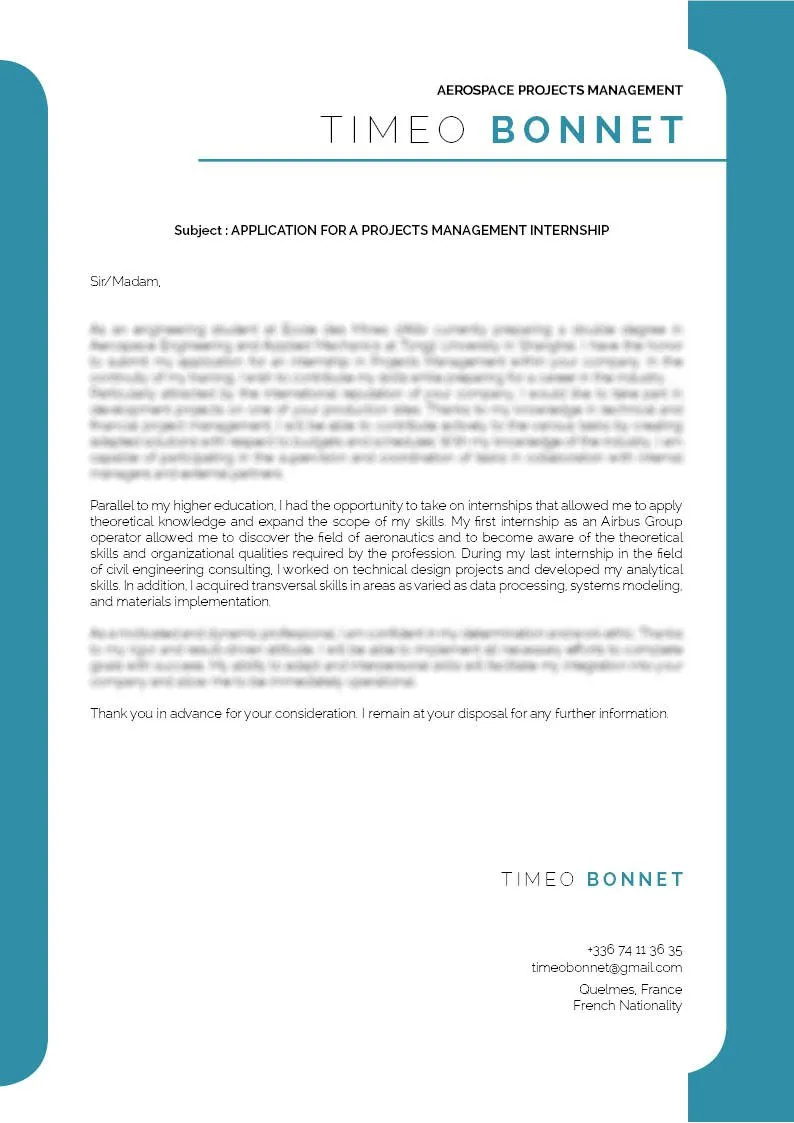
Before writing your engineer cover letter, research the company and the role. Visit the company’s website, read its mission statement, and learn about its products, services, and values. Understand the company’s culture and what makes it unique. Research the specific role by reviewing the job description thoroughly. Understand the responsibilities, required skills, and qualifications. Knowing about the company and the role will help you tailor your cover letter and demonstrate your genuine interest. You can use this information to highlight relevant experiences and skills, aligning your qualifications with the company’s needs. This level of preparation shows that you are a proactive and dedicated candidate, significantly increasing your chances of securing an interview.
Using Keywords Effectively
Using keywords effectively in your engineer cover letter is essential for getting noticed by applicant tracking systems (ATS) and human readers. Review the job description and identify the key skills, qualifications, and buzzwords the employer uses. Integrate these keywords naturally throughout your cover letter, especially in the skills and experience sections. Avoid keyword stuffing, which can make your letter sound unnatural and unprofessional. Instead, use keywords in context, demonstrating your understanding of the role and your ability to meet the job requirements. Strategically using keywords ensures that your cover letter is relevant and easily searchable by both automated systems and human readers, increasing your chances of getting an interview.
Engineer Cover Letter Examples
Reviewing engineer cover letter examples can provide valuable insights and help you structure your own letter effectively. Search online for cover letter templates and examples specific to engineering roles. Pay attention to how other candidates highlight their skills, experience, and achievements. Study the language they use, the format they employ, and the tone they adopt. While using examples as a guide, remember to personalize your cover letter to reflect your unique qualifications and experiences. Avoid directly copying and pasting content from examples; instead, adapt the examples to fit your background and the specific job requirements. Reviewing examples can inspire and give you ideas on how to present yourself in the best possible light and showcase your abilities.
